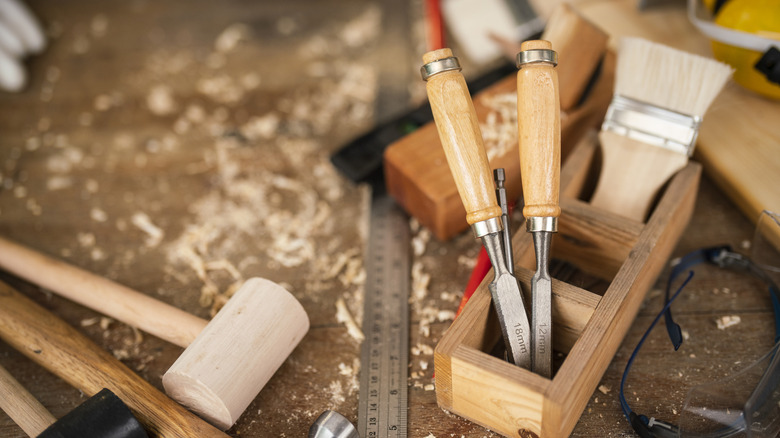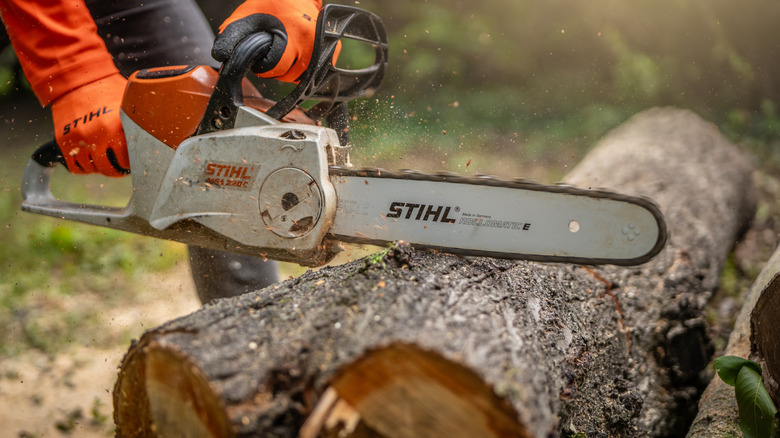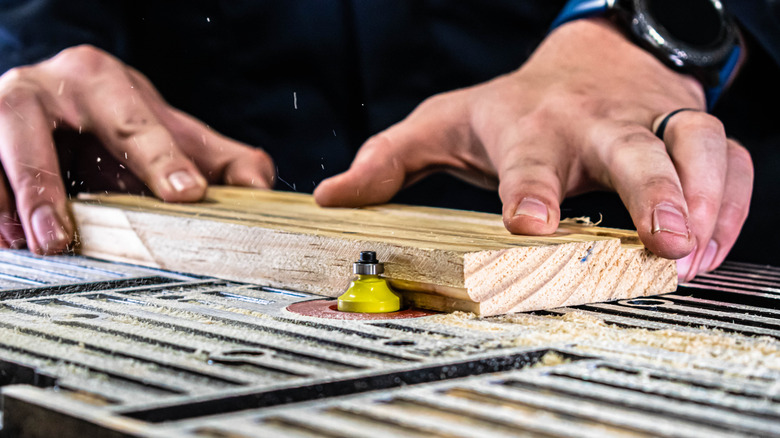5 Woodworking Tools To Avoid As A Beginner
The call of the wood shop is a persistent one. Many people from all sorts of backgrounds have been caught by the allure of woodworking, and it's easy to see why. Working with your hands and creating something is a natural stress reliever of sorts. With more and more people spending their working hours sitting at a desk, it's not surprising that woodworking is once again a popular hobby.
There are lots of excellent resources online for woodworkers. For beginners, woodworking YouTube channels are a great place to start from. Of course, this isn't exactly a cheap hobby, but the world is full of woodworking tools you can buy for under $20 to kickstart your journey. The same is true of those essential tools for advancing your skills, many of which aren't nearly as expensive as they used to be.
However, these and other pieces of equipment aren't really designed for beginners. Industrial equipment is obviously difficult to work with for those lacking the experience necessary to manage all their nuanced settings, but it doesn't end there. Some tools are just bad, too, and beginners won't always be able to recognize them for what they are. There are a lot of woodworking tools to avoid if you're a beginner, but let's start with five of the most common ones.
Bandsaw
The bandsaw is a complicated tool, there's no getting around it. As is the case with many power tools, understanding the nuances of the equipment isn't just essential for getting the most out of it, but stands as a baseline requirement to use the gear safely. Bandsaws have many moving parts and function as a brutal cutting tool that can deliver grizzly injuries to those not careful enough. Unlike other saws that early career woodworkers will be familiar with, the bandsaw incorporates a large vertical blade that doesn't look like a typical cutting implement. This feature is wrapped around moving wheels that are driven by a series of gears housed within the unit. Some feature a simple speed adjustment lever, but often, any change requires you to tinker with gears in the headstock, making it very easy to make mistakes, which can result in botched projects and sometimes even injuries.
Fortunately, this isn't a tool that most woodworkers need on a daily basis. The bandsaw is the most effective solution when ripping large boards lengthways, and can also be relied upon to create wavy cuts. However, there are plenty of alternatives to a bandsaw. Starting with the obvious, you don't need a bandsaw if you can simply avoid buying lumber that's too big for your needs. Alternatively, a table saw and a jig can produce this kind of cut quite well.
Drill press
The drill press is one of the most dangerous woodworking tools you can find in a shop. As is the case with bandsaws, you can find lots of moving parts even in basic drill presses. More importantly, it's easy to use a drill press incorrectly. It can be tempting to turn the wheel hard as the bit begins a cut, but experienced drill press users know that performing drilling operations with this tool is all about a careful application of pressure. Dialing in the right speed settings and applying just the right amount of force is a difficult skill to learn. There's also a need to back the bit out of the hole you're creating from time to time to remove waste, and give it time to cool down when working through a considerable number of cuts.
It's also important to note that drill presses can be expensive tools. Many workshops will need this tool, but the drill press is often one of the least used assets in a typical setup. Buying a good drill press early in your woodworking career will almost certainly feel like a waste of money as a result. All of this combined makes the drill press something that you shouldn't invest in until you find a real, tangible need for it.
Chainsaw
A chainsaw might sound like a weird entry on this list. Many homeowners who spend time on landscaping tasks will own a conveniently lightweight chainsaw. There are lots of different types and brands of chainsaws: Stihl, one of the best brands of chainsaws, makes a variety of saws for different tasks. However, chainsaws can be as valuable to woodworkers as they are to landscapers. This can be an important tool if you're looking to cut boards out of a fallen tree, or when creating a live edge table, for hogging out knots and other imperfections. It's also useful on jobs that require an almost sculptor-like approach.
All this is to say that chainsaws have an important (if niche) role in a woodworker's toolkit. However, this tool is built with cutting power in mind, and is not a delicate cutting solution, making it hard to use for woodworking and, more importantly, potentially dangerous. One of the easiest ways to get hurt when using a chainsaw involves the blade getting stuck in wood and kicking back toward the user's face. When deploying a chainsaw outside its primary use case, especially if you're not very experienced, you may be tempted to disregard safety gear, placing you at a much greater risk of injury.
Router Table
The router table is found in many professional settings, including woodworkers' shops. Even those who prefer hand tools use router planes to cut soft edges or channel out grooves in their workpieces. Because routers come in so many different formats, it can be difficult to identify the appropriate solution for your particular needs. The router table can feel like a big step towards a professional woodworking setup, which is why so many early-stage woodworkers jump right to this approach. However, a router table can backfire in a lot of different ways.
The first problem is the router table's size. Router planes and handheld router power tools are small, mobile, and can be stored away when not in use, while a router table requires a lot more space, and can't be easily stored away. If you're a beginner woodworker, there's a good chance you're working from a corner of the garage or a shed in the backyard, if you're lucky. This makes space a vital resource, and one that a milling table will immediately consume. This is to say nothing of the tool's unique ability to create a dangerous working environment. Placing a spinning cutting blade facing up as you move workpieces across the table is exactly as safe as it sounds. Newer woodworkers would do better to start with a handheld router and explore this cutting tool's potential to its fullest.
Jointer
While many professional woodworkers don't actually use their jointers very often, this piece of equipment is a must-have for those who have graduated into the upper echelon of woodworking. This is where the jointer belongs: with professional woodworkers, in a dedicated shop. Intermediate and even advanced woodworkers that don't have the space, budget, or usage needs shouldn't feel pressured to include a jointer in their workflow. This tool is great for flattening and squaring raw lumber, and it regularly generates savings for the professionals that know how to use it. At the same time, the jointer is one of the most expensive pieces of woodworking equipment you could buy, and it's large and difficult to use as well.
Another problem of a jointer is how easy it is to misuse. Highly skilled woodworkers know this well, but beginners might not realize that a jointer isn't a one-stop solution to flattening boards. It must be used in tandem with other tools, and those who don't understand how to properly incorporate the jointer into their workflow will feel tremendously let down by this expensive addition.





